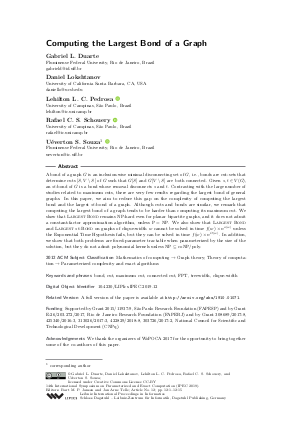LIPIcs.IPEC.2019.12.pdf
- Filesize: 0.5 MB
- 15 pages

 Creative Commons Attribution 3.0 Unported license
Creative Commons Attribution 3.0 Unported license

A bond of a graph G is an inclusion-wise minimal disconnecting set of G, i.e., bonds are cut-sets that determine cuts [S,V\S] of G such that G[S] and G[V\S] are both connected. Given s,t in V(G), an st-bond of G is a bond whose removal disconnects s and t. Contrasting with the large number of studies related to maximum cuts, there are very few results regarding the largest bond of general graphs. In this paper, we aim to reduce this gap on the complexity of computing the largest bond and the largest st-bond of a graph. Although cuts and bonds are similar, we remark that computing the largest bond of a graph tends to be harder than computing its maximum cut. We show that Largest Bond remains NP-hard even for planar bipartite graphs, and it does not admit a constant-factor approximation algorithm, unless P = NP. We also show that Largest Bond and Largest st-Bond on graphs of clique-width w cannot be solved in time f(w) x n^{o(w)} unless the Exponential Time Hypothesis fails, but they can be solved in time f(w) x n^{O(w)}. In addition, we show that both problems are fixed-parameter tractable when parameterized by the size of the solution, but they do not admit polynomial kernels unless NP subseteq coNP/poly.






























Feedback for Dagstuhl Publishing